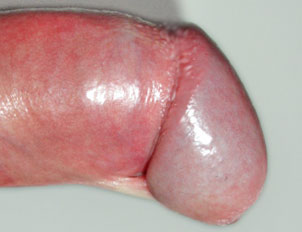

Circumcision is a surgical procedure that involves partial or complete removal of the foreskin (prepuce) of the penis. This is usually done under general anaesthetic as a day case procedure (ie: you will not need to stay overnight in hospital).
At Cambridge Urology Partnership, we only see patients older than 16yrs old. The most common reason for a circumcision in adults are a tight foreskin, or phimosis, In this condition, the opening of the foreskin is narrowed, preventing retraction. This may cause problems with intercourse or infections, and thus a circumcision is usually advised.
Steroid cream may be used to relieve inflammation and avoid circumcision. If the frenulum is tight, then a frenuloplasty may be performed instead.
 In some men the foreskin is not tight, but there is a tight band of tissue from the underside of the tip of the penis to the underside of the foreskin. This can become torn during intercourse and bleed, or cause pain. In these patients, a small operation called a frenuloplasty can be performed. In this procedure the tight band is divided thus curing the problem. The procedure can be done under local anaesthetic.
In some men the foreskin is not tight, but there is a tight band of tissue from the underside of the tip of the penis to the underside of the foreskin. This can become torn during intercourse and bleed, or cause pain. In these patients, a small operation called a frenuloplasty can be performed. In this procedure the tight band is divided thus curing the problem. The procedure can be done under local anaesthetic.
You will usually be admitted on the same day as your surgery. You will normally receive an appointment for pre-assessment before your admission, to assess your general fitness and to perform some baseline investigations. After admission, you will be seen by your Consultant. You will be asked not to eat or drink for 6 hours before surgery and, immediately before the operation. What happens during the procedure?
A full general anaesthetic (where you will be asleep throughout the procedure), a spinal anaesthetic (where you are awake but unable to feel anything from the waist down) or a local anaesthetic injection around the penis may be used. All methods minimise pain; your anaesthetist will explain the pros and cons of each type of anaesthetic to you, or if you have already discussed this with your urologist and planned to have a local anaesthetic in the clinic then this method will be used.
Local anaesthetic is also injected into the base of the penis to aid pain control after the operation. The entire foreskin will be removed using an incision just behind the head of the penis. This leaves the head of the penis completely exposed with no redundant skin.
You may experience discomfort for a few days after the procedure but painkillers will be given to you to take home. Absorbable stitches are normally used which do not require removal. Vaseline, or ointment provided to you, should be applied to the tip of the penis and around the stitch line to prevent the penis from adhering to your underclothes and it is advisable to wear light clothing for 2-3 days. Passing urine will be painless and will not be affected by the operation. The average hospital stay is less than 1 day.
Most procedures have a potential for side-effects. You should be reassured that the majority of patients do not suffer any problems after this procedure. Common side-effects include swelling of the penis lasting several days, oozing of small amounts of fluid between the stitches for a few days, and temporary increased sensitivity of the head of the penis.
It will be at least 10 days before healing occurs. You may return to work when you are comfortable enough. Most people require at least a week off work. You should refrain from sexual intercourse for a minimum of 4 weeks.
There will be marked swelling of the penis after a few days. This will last up to 7 days and will then subside but do not be alarmed because this is expected.
However, if you develop a temperature, increased redness, throbbing or drainage at the site of the operation, please contact your doctor.
The head of a circumcised penis will look something like the picture below afterwards.